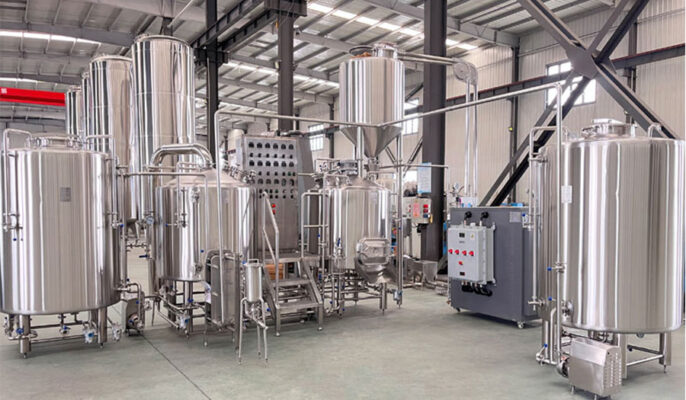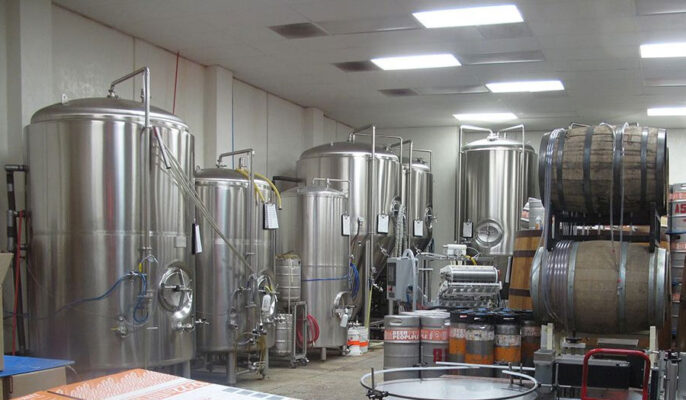The craft beer industry has boomed in recent years, with more and more enthusiasts taking their passion for quality beer to the next level by starting their microbrewery. In this guide, we’ll look in-depth at microbrewery start up costs and explore the essential steps and costs in turning your beer dreams into reality.
¿Qué es un microcervecería?
Una microcervecería es una empresa cervecera a pequeña escala que produce cantidades limitadas de cerveza artesana. A diferencia de las grandes cervecerías comerciales, las microcervecerías se centran en la calidad, la innovación y el arte de elaborar cerveza. A menudo se dirigen a nichos de mercado y ofrecen sabores únicos y cervezas para gustos específicos. La popularidad de las microcervecerías ha aumentado por varias razones. Los consumidores buscan cada vez más productos auténticos y locales, y las microcervecerías encajan perfectamente en esta tendencia.

¿Cómo se abre una microcervecería?
Determine su mercado objetivo
Before considering startup costs, it’s crucial to conduct thorough market research and develop a solid business plan. Identifying your target market will help you determine the type of beer you want to produce, the size of your operation, and the best strategy for engaging your audience: research local demographics, current industry trends, and competition to make informed decisions.
Requisitos legales y de autorización
Small breweries must comply with federal regulations, including obtaining a brewer’s notice from the Alcohol and Tobacco Tax and Trade Bureau (TTB). Warranty requirements and labeling approvals also need to be considered. Be sure to budget for these costs, as well as any professional fees associated with dealing with a complex regulatory environment.
Ubicación y espacio
Choosing the right location is critical to the success of your small brewery. We’ll discuss the factors to consider when choosing the right space for your business.
Equipos y suministros para la fabricación de cerveza
The heart of any small brewery is its brewing equipment. We’ll introduce you to the basic brewing equipment and supplies you’ll need to get your operation up and running.
Personal y formación
A well-trained and enthusiastic team is essential to making great beer. We’ll discuss how to hire the right people and provide them with the necessary training.
Costes de puesta en marcha de una microcervecería
- Costes del microequipo: Invertir en el equipo cervecero adecuado puede suponer un importante gasto inicial. Le ofrecemos información sobre los costes asociados a la compra o el alquiler de maquinaria cervecera.
- Costes de permisos y licencias: Cumplir con los requisitos legales a menudo requiere costes. Infórmese sobre los costes que conlleva la obtención de las licencias y permisos necesarios para su microcervecería.
- Alquiler y servicios: Conseguir un local adecuado y gestionar las facturas de los servicios públicos pueden aumentar los costes de puesta en marcha. Aprende a presupuestar estos gastos recurrentes.
- Presupuestos de marketing y promoción: El marketing es esencial para el éxito en un mercado competitivo. Le guiaremos en la asignación de presupuestos para aplicar estrategias eficaces de marketing y promoción.
- Otros gastos: Deberá tener en cuenta otros gastos. Desde el seguro hasta los costes iniciales de las materias primas, te ayudaremos a elaborar un presupuesto exhaustivo.
Selección de materiales para equipos de microcervecería
Equipo cervecero de cobre
El equipo de cobre se ha utilizado durante siglos en la producción de cerveza gracias a su estructura. Mueve el calor en la olla de forma rápida y uniforme para cocer el mosto al vapor. Normalmente, la gente empieza a elaborar cerveza con utensilios de cobre porque es muy adecuado para cocer al vapor el mosto a altas temperaturas. El cobre tiende a reaccionar rápidamente con otros productos químicos y a producir un sabor metálico en la cerveza. Diferentes procedimientos de limpieza y desinfección pueden cambiar el color de la cerveza elaborada con ollas de cobre.
Equipamiento de acero inoxidable para cerveza
In today’s world, we focus on the finished product, and all large industrial breweries use stainless steel beer equipment. The tanks used there are not completely made of stainless steel, and there is copper cladding on each tank to ensure a natural look, but it will not conflict with the taste unless it is bleached. The stainless steel material does not actively react with chemicals, but it tends to react with chlorine, so proper disinfection will not affect the quality of beer brewed in stainless steel brewing equipment. Stainless steel is a stronger material than copper, so it will not cause stress when steaming wort at high temperatures. It will be a durable choice in the brewery.
Costes del equipo de microcervecería
El equipo suele ser el mayor coste a la hora de poner en marcha una fábrica de cerveza. El equipo cervecero de pequeña capacidad (1 barril, que produce 320 barriles de cerveza de 12 onzas) puede adquirirse a menudo nuevo o usado por $100.000 o menos. Sin embargo, por un gran sistema de elaboración de 30 barriles que pueda producir 9.600 botellas de cerveza de 12 onzas, se puede llegar a pagar hasta $1 millón.
Tanto si se compra nuevo como usado, el equipo típico necesario para empezar a elaborar cerveza incluye:
Equipo de fabricación de cerveza
- Sistemas de elaboración de cerveza: Incluyen ollas de cocción, tanques de mosto, tanques de fermentación y más. Estos equipos suelen ser el corazón de la producción de cerveza, y su calidad y capacidad afectan directamente a su capacidad de producción y a la calidad de su cerveza.
- Sistema de refrigeración: se utiliza para controlar la temperatura durante el proceso de fermentación para garantizar una temperatura estable y controlada durante la fermentación de la cerveza.
- Equipos de llenado: utilizados para llenar cerveza en botellas, latas o barriles, incluidas máquinas de llenado, máquinas de sellado, etc.
- Limpieza y desinfección del equipo: Mantener el equipo y los recipientes higiénicos es clave para la seguridad de la producción y la calidad de la cerveza.

Equipos de apoyo
- Calderas: proporcionan vapor o agua caliente para calentar el agua de cocción y el lúpulo.
- Compresores de aire: utilizados para accionar equipos accionados por aire, como máquinas de llenado y sellado.
- Equipos de tratamiento del agua: garantizan que el agua utilizada en el proceso de fabricación de cerveza cumpla las normas.
Equipos de fermentación
- Equipo de control de la fermentación: incluye controladores de temperatura y accesorios del fermentador para supervisar y controlar la temperatura y otras condiciones durante el proceso de fermentación.
- Equipos de almacenamiento y maduración: utilizados para almacenar la cerveza terminada, incluidos los tanques de almacenamiento o barriles.
Equipos y herramientas auxiliares
- Molino de malta: muele la malta hasta convertirla en polvo apto para la elaboración de cerveza.
- Equipo de cultivo de levadura: utilizado para cultivar y mantener cepas de levadura.
El tamaño de una microcervecería
El tamaño de la cervecería es el principal factor que determina el coste del equipo de microcervecería. Si su actividad es de mayor envergadura, necesitará un equipo y una fábrica de cerveza más grandes. Una fábrica de cerveza está equipada con un mezclador de mosto, un tanque de cerveza caliente, un remolino, un hervidor y una cuba filtro. Normalmente, la capacidad de una fábrica de cerveza se determina en barriles por barril (BBL). El Grupo Micet fabrica cervecerías de diferentes capacidades en función de las necesidades de nuestros clientes.




